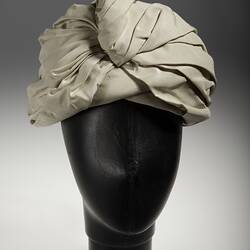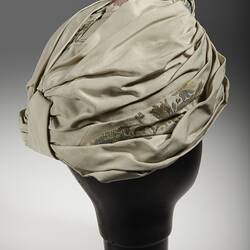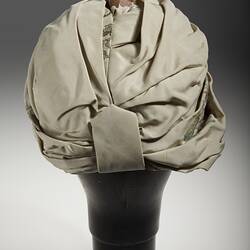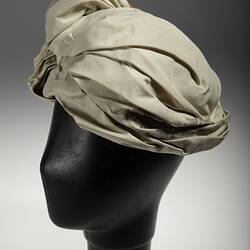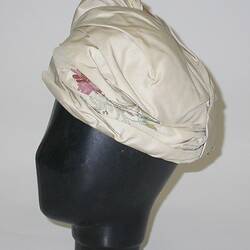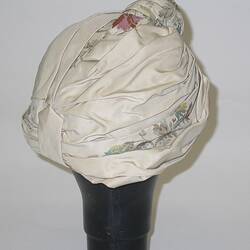Summary
Turban, sparterie shape, draped with shantung fabric. Made by Jean Rooks, Eaglemont.
Part of a collection of hats ordered and worn by Lorna Waller (1912-1997), an artist and aesthete. The collection represented the avant-garde of fashion in 1940s Melbourne. Some of the hats were made locally, and some were imported.
Millinery styles varied enormously between the late 1930s and the early 1950s. In the late 1930s, Salvador Dali and other Surrealists had a dynamic impact on the range of hat shapes. The onset of World War II resulted in a shortage of materials to make hats, so trimmings were used to create an upbeat mood in the face of hardship. Towards the end of the War, restraint was the key look, and the turban was again popular. Later, gaiety prevailed and, with it, feathers were back.
Born in New Zealand, Lorna travelled overseas when young and settled in Melbourne. While at the National Gallery School in the mid-1930s, she took up with her teacher, the artist Napier Waller. They did not marry until 1954, when his first wife died. An independent income enabled Lorna to maintain an apartment in Spring Street, decorated in a bohemian style. The leopard skin prints and slacks she once wore to the Lyceum Club proved too much for conservative Melbourne: she was told to go home and change.
Physical Description
Turban, sparterie shape, draped with shantung fabric.
More Information
-
Collecting Areas
-
Acquisition Information
Donation from Ms Anthea Mereweather, 18 Dec 2001
-
Manufacturer
Jean Rooks, Eaglemont, Greater Melbourne, Victoria, Australia, 1960-1969
Date based on appearance. -
User (Probable)
-
Inscriptions
Text on tag: CREATED BY/Jean Rooks/EAGLEMONT.
-
Classification
-
Category
-
Discipline
-
Type of item
-
Overall Dimensions
21 cm (Width), 22 cm (Depth), 13 cm (Height)
-
Dimensions
200 mm (Length), 230 mm (Width), 130 mm (Height)
Measurement From Conservation. Measuring Method: Maximum measuring methods
-
References
Text regarding Lorna Waller and history of millinery drawn from exhbiition label draft in sup-file, dated 22/10/2002.
-
Keywords

